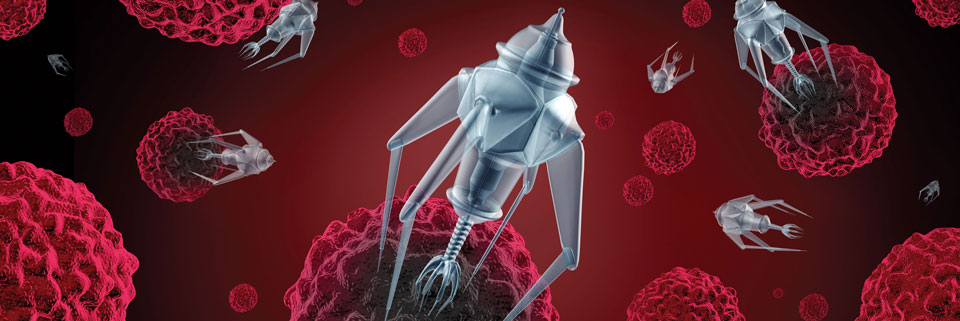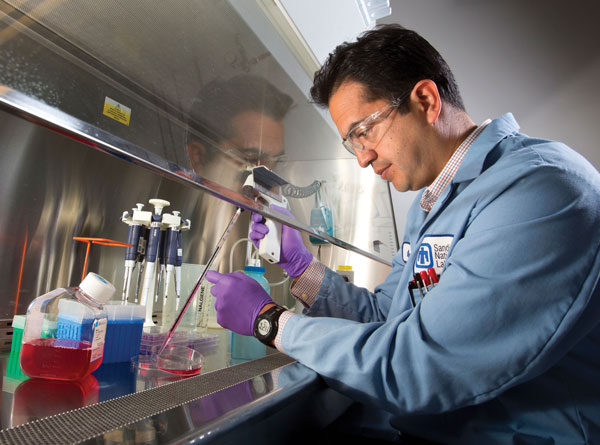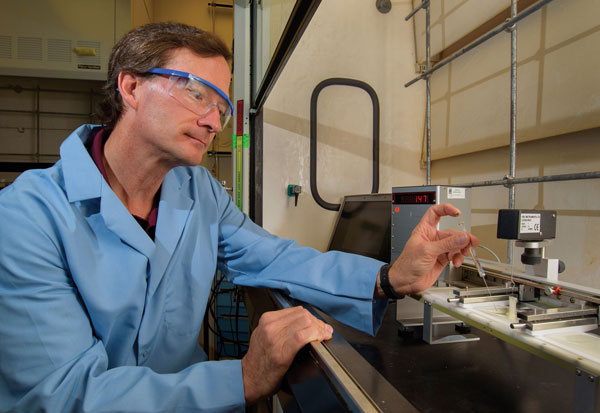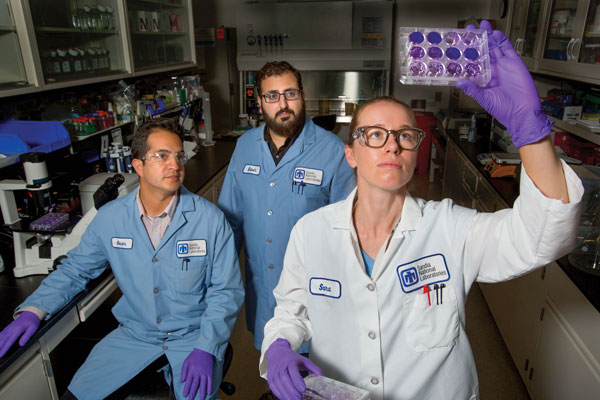Living and non-living materials don't have to keep their distance. Bringing them together can create hybrid systems for a bold new world.


Augmented super-soldiers, self-healing materials used in cars and airplanes and using genetic engineering to fight off infections sound like things straight out of science fiction. And they are, for now.
Sandia’s ENgineering Abiotic-Biotic Living Systems (ENABLS) Research Challenge aims to turn science fiction into science fact. More specifically, ENABLS is tackling the molecular-level interface between biology and non-living materials to engineer hybrid systems that combine the strengths of both.
“ENABLS will take what we know about materials, what we know about biology and how biological systems interact with their environments, and build a more capable way of interfacing the two,” says Steve Casalnuovo, deputy for the Research Challenge.
Even the humblest bacterium is an expert at sensing, responding to and manipulating its environment, says Casalnuovo. But, living things are quite fragile and can be killed by changes in the environment, including temperature, pressure, radiation and chemicals. Man-made materials are generally robust over a broader range of conditions but lack biology’s exquisite ability to sense and respond, he adds.
By bringing together biologists, chemists, physicists and materials scientists, ENABLS seeks to take the strengths of both biology and non-living materials to make something even better: a hybrid system that can be tailored and optimized according to different needs, says Casalnuovo.
Slice and dice pathogenic invaders
ENABLS’ first effort is the NanoCRISPR Grand Challenge. This bold, three-year project combines recent advances in biology and nanomaterials to develop adaptable, safe and effective responses to biological threats and new pathogens, says Darryl Sasaki, principal investigator for the challenge.
Using porous silica nanoparticles to deliver a powerful new genetic engineering tool, CRISPR (clustered regularly interspaced short palindromic repeats), to where it needs to act, the NanoCRISPR team hopes to slice-and-dice the genome of invaders for public health and biodefense.

Unlike previous genetic engineering tools, such as zinc-finger nucleases or TALEN constructs, the CRISPR system is more adaptable, more precise and has transformed biology since major advances in 2012. Like previous genetic engineering tools, however, the CRISPR system by itself cannot target and enter cells and is thus ineffective without a delivery system.
That’s where the nanoparticles come in, says Casalnuovo. They can envelop and protect the delicate complex as it travels through the body. The outside of the nanoparticle can be coated with signaling molecules that camouflage the particle and direct it to the right place, such as the invading pathogen or specific organs and tissues targeted by the pathogen.
Sasaki says they have made great strides in encapsulating the biological cargo in the nanoparticles, deliver-ing the cargo to model cells and triggering a genetic change. Through computer modeling, cellular assays and animal model studies, they hope to develop CRISPR-based countermeasures for the Zika virus and a drug-resistant bacterium.
Sandia’s previous encapsulation work involved much smaller drug molecules such as antibiotics. Casalnuovo says CRISPR’s protein-RNA complex is larger, more complex, more sensitive to the environment and needs to be delivered more precisely than the previous drug molecules.
Immune systems of the future

The next step for the ENABLS Research Challenge after the NanoCRISPR Grand Challenge is being evaluated. Possible paths forward include using biotic/abiotic nanoparticles to confer enhanced capabilities on the warfighter, developing a controlled microbial community in the human gut to serve as a first line of defense against infection or focusing on biotic/abiotic hybrids for energy-related applications or to make self-repair-ing materials.
Another possible path forward focuses on adapting the immune response in biological systems to make human-designed systems more robust. Many systems, from algae ponds grown for biofuels to mechanical structures, would benefit from the ability to recognize when things deviate from normal, learn from past experience, and initiate a repair, says Casalnuovo.
By fully understanding how nature employs biological design rules, researchers can improve non-biologic components, better interface the living and non-living systems and engineer the hybrid systems, Casalnuovo says.
“This is a hard problem from a lot of different perspectives. This Research Challenge is a 10- or 20-year effort, maybe even 50 years of work, with the potential for some really transformative things,” says Casalnuovo. “This work has the potential to change the way we live.”